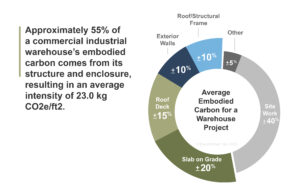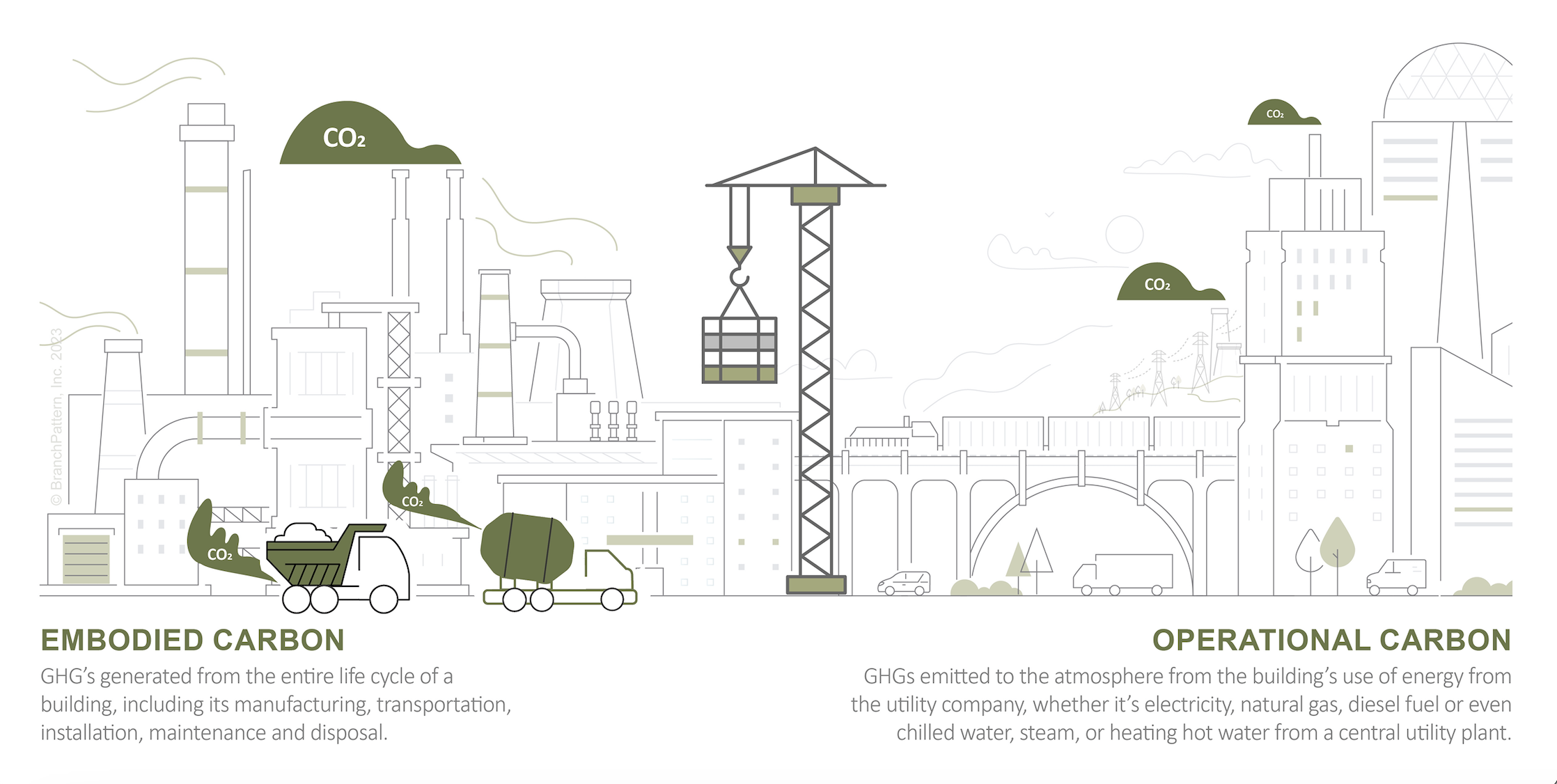BranchPattern, a national sustainability and engineering firm, has released its highly anticipated 2023 Benchmark Study on Embodied Carbon in U.S. Industrial Real Estate. In partnership with five major industrial real estate developers (Affinius Capital, Bridge Industrial, Brookfield Properties, IDI Logistics, and Prologis), the study reviewed how the industry is defining carbon
emissions, the typical contributors, and the reduction strategies the industry is considering. The study included analysis of 26 projects, by nine separate developers, located in six different regions in the U.S.

The study found that the average embodied carbon intensity of the 26 U.S. industrial core & shell buildings, excluding the site work or tenant fit-out, was 23.0 kg CO 2 e/ft 2. Embodied carbon emissions from buildings account for 11% of total global greenhouse gas emissions and represent a significant impact on climate change as the vast majority of those emissions occur in the first year of the building’s lifetime. As buildings become more energy efficient and rely more on renewable energy on-site or from the grid, this study suggests that more attention should be given to embodied carbon as an opportunity for the real estate industry to reduce the environmental impact of buildings.
Developers, material suppliers, and general contractors have the incredible opportunity to dramatically reduce embodied carbon emissions. Yet prior to this study, the best data available for embodied carbon emissions comes predominantly from the office and multifamily sectors. This report emphasizes the value of having comparative data to help the industrial sector make informed decisions when designing and constructing this building type.
A strategic, transparent, and shared approach to reducing and measuring GHG emissions can support global commitments to reduce GHGs. The study summarizes benchmark calculation methodology, innovation, and reduction strategies, and how the United States and the global community might consider embodied carbon emissions in the future.
The release of BranchPattern’s 2023 Benchmark Study on Embodied Carbon in U.S. Industrial Real Estate marks an important step forward in the efforts to reduce GHG emissions in the building industry. By establishing a standard practice of measuring, benchmarking, and reducing embodied carbon, the study provides a roadmap for the industrial sector to build more sustainable and resilient buildings, contributing to global efforts to combat climate change.
“We recognize that even though it’s the largest data set analyzed to date, the 26 buildings included in the study are not a large enough sample size to establish a standard for the whole industry. However, this data is a valuable point of reference. The study’s methodology and findings can help the industrial development sector better track and report embodied carbon transparently to promote construction materials and methods that reduce emissions.” said Nate Maniktala, principal at BranchPattern.
Quotes from partner organizations:
- “To help ensure our sustainability efforts have quantifiable impacts, Affinius Capital has committed to conduct embodied carbon accounting for all new industrial developments in 2023 and going forward. This accounting effort will include all A1-A3 emissions associated with each new development and will establish an emissions baseline that we will not only report against but strive to improve as we implement innovative technologies and construction methodologies.”~ Josh Hullum, executive director of construction at Affinius Capital.
- “As a leading industrial real estate developer, Bridge has a critical role to play in reducing the ~40% of global carbon emissions attributable to the built environment. With the help of BranchPattern, Bridge is conducting whole-building life cycle assessments to better understand the embodied carbon impact of different materials and construction technologies so we can begin incorporating innovative techniques to reduce the embodied carbon of our projects.” ~ Francesca De Amicis, vice president, sustainability at Bridge Industrial.
- “Brookfield Properties is committed to advancing the development GHG emissions-free assets and minimizing embodied carbon within building materials and systems.” ~ Devin Barnwell, managing partner, global head of portfolio management, logistics, Brookfield Asset Management at Brookfield Properties.
- “As a leader in logistics development, prioritizing the reduction of embodied carbon in our developments- even beyond contemplated government mandates- is a first and vital step in reaching our global emissions reduction targets.” ~ Nicole Ivers, vice president, global head of environmental, health and safety, logistics at Brookfield Properties.
- “We are at a pivotal moment for owners and developers of real estate to look beyond the greenhouse gases emitted during building operations. As industrial developers, the emissions embodied within large, concrete and steel buildings have an outsized role in the assets’ total carbon footprint. Working with industry peers, key partners and suppliers to create pathways to lower carbon materials, design and construction techniques is an integral part of reducing the impact buildings have in climate change.” ~ Chris Brown, solar development and ESG director at IDI Logistics.
- “Improved accounting and disclosure on embodied carbon will help identify and promote the lowest carbon construction materials and practices across the industry. Given our company’s global scale and leadership in sustainable development, we welcome opportunities to collaborate with partners like BranchPattern in this effort and in pursuit of our net zero goal.”~ Suzanne Fallender, vice president, global ESG at Prologis.









